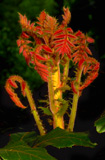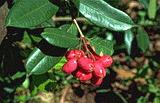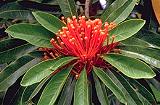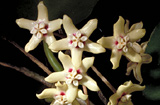Soil PreparationWell dug up, thoroughly loosened soil is absolutely essential. For a plant to produce good growth above the ground, it must have a strong and well-developed root system below the ground. Basically, plant growth is directly proportional to root growth. Roots cannot grow in hard ground, and this is particularly true of rainforest plants. In contrast to the aggressive root systems of the open forest eucalypts and wattles, rainforest trees have roots which are, in general, quite timid. The seedlings are adapted to stop growing and to remain dormant on the forest floor for years, waiting for a gap in the canopy to give them light and a space to grow in. In cultivation, this same dormancy is very readily induced by any kind of obstacle, such as hard ground or root competition from grass, weeds or existing trees. Rainforest trees must be given very well prepared soil if they are to grow. The soil should be loosened to a depth of about 50 centimetres. Area is much more important than depth - prepare an area of at least 1 metre diameter for each plant. Rainforest plants should be planted about 1.5 metres apart (and no more than 2 metres). This means that entire garden beds should be prepared rather than individual holes being dug for each plant. Consider the use of machinery to prepare the soil. A bulldozer with rippers does an excellent job on acreage blocks. Smaller machines such as a backhoe or bobcat do a great job in suburban yards. A rotary hoe is suitable for most soils provided the ground is not rocky, although in heavy clay soils it may cause problems as they rotary action can leave a hard polished surface beneath the loosened layer. Be sure to set the cultivator as deep as it will go. Rotary hoes can also be used to thoroughly prepare the surface soil after a bulldozer or bobcat has done the initial loosening. Finely cultivated soil will improve both the growth rate and the survival rate because it allows the plant to produce the maximum number of feeder roots. Considering the amount of ground a machine can prepare in an hour compared to a person with a pick and shovel, bulldozer, bobcats and rotary hoes are extremely cost-effective and well worth the expense. Nevertheless, always apply common sense to a situation! For instance, it is quite unnecessary to use machinery to prepare a bed on beach sand, and it would be totally irresponsible to use a bulldozer to rip the soil on a steep creek bank. Post hole diggers are totally unsuitable for preparing the soil for rainforest plants. Firstly, a deep, narrow post-hole is the wrong shape for rainforest plants which require just the opposite - a large area of loosened soil for their surface roots and a depth of only about 50 centimetres. Secondly, post hole diggers usually produce a hole with hard, polished sides through which the timid roots of rainforest plants have great difficulty penetrating. In most soils rainforest plants planted in post-holes have very poor growth rates. It is often difficult to prepare a garden bed in heavy clay soil. In this case, a top dressing of gypsum will help to break down the clay and condition the soil. Do not use dolomite or lime as these will raise the pH of the soil, and may make the soil too alkaline for good growth. MulchA thick layer of organic mulch is absolutely essential for several reasons. It reduces evaporation of water from the soil thus reducing the amount of watering needed and it conditions and enriches the soil as it decomposes. It provides a nutrient-rich layer for surface roots to feed in; prevents the growth of weeds and grass; and keeps the soil cool. It also enhances the populations of soil micro-organisms which are necessary to recycle nutrients and keep harmful disease organisms under control.
The importance of keeping the root-run cool and preventing the growth of grass and weeds cannot be stressed enough. Rainforest plants have a large network of surface roots obtaining nutrients from the decaying organic material to top of the soil. If the soil surface is hot, these important surface roots are killed and the growth rate of the plants is greatly reduced. Grass and weeds severely inhibit the growth of plants and, while this is true for all garden plants, it is especially important to bear in mind when dealing with rainforest species. Any organic matter is suitable for mulch. Use whatever is available locally at a reasonable price. Peanut shell, bagasse, woodchip and hay are excellent. Use grass clippings and garden prunings - any mulch is better than no mulch at all. Do not use black plastic or weed mat to control weeds - both materials cause the ground to heat up unless they are buried beneath a very thick layer of mulch, in which case there is no need to use them anyway. Black plastic prevents nutrients from the decaying mulch entering the soil and becoming available to the plant, and by preventing air movement through the soil can cause the soil to turn sour. Plants planted in weed mat may be strangled as the trunk diameter expands beyond the size of the initial hole. Where weeds are a particularly difficult problem, one or two treatments with chemical weedicide will generally eliminate the problem for good.
Full SunMost rainforest plants require full sun to grow well and to flower. When planted in the full sun, rainforest plants become very bushy, retaining thick foliage quite low to the ground, and grow only to about a quarter to a third of their height in the forest. It is only the intense struggle for light inside the forest which creates the giants in the wild. There are a few exceptions of course, but in general, rainforest trees are quite manageable in home garden situations.
"Cover plants" or "pioneers"It is a fallacy that rainforest trees need a cover of fast growing pioneer trees in order to become established. In fact, pioneer trees severely inhibit the growth of other rainforest trees for a least two reasons. Firstly, they create shade, thus limiting the sunlight which is necessary for growth. More importantly these "pioneers" have extremely aggressive root systems against which a typical rainforest species has virtually no hope of competing. About the only conditions under which the user of pioneers may be justified is in localities which are very frost prone, or which are exposed to extremely dry winds, and some from of protection is therefore necessary. However, a thick screen of callistemons, melaleucas and other natives around the windy edge is a preferable way of dealing with this problem. Soil TypeRainforest plants can be grown in most soil types. Unlike other native plants, rainforest plants obtain most of their nutrients more or less directly from the decaying organic matter on the forest floor, rather than from the soil itself. Rainforest soils are usually very poor in nutrients and their role is that of a medium in which to anchor the plant rather than as a source of nutrients. The pH of the soil is important for good growth. In the rainforest the large mass of organic material in the top layer of soil acts as a buffer to pH changes so that the layer in which most of the feeder roots are found usually has a pH of 5 or 6, regardless of the pH of the actual soil. A pH of between 5 and 6 is the optimum level at which nutrients are available for rainforest plants. Most Australian soils fall into this range, and so the pH of the soil is not usually a problem, especially when there is a tick layer of organic mulch. If your soil is definitely too acidic, it may be corrected with lime; if too alkaline, it may be corrected with sulphur. For heavy clay soils a top dressing of gypsum is also a great advantage. As the organic material builds up in the soil from the initial mulch and leaf drop, the pH level will tend to stabilise. Garden BedsRainforest plants, like most plants, grow much better when in the company of others. Plants positioned on their own rarely grow as well as those planted in groups in beds. There are several reasons for this. Plants in groups work together to modify the micro-climate of their immediate area to their collective advantage; they trap humidity, break up the wind and cast dappled shade over the ground, all to the benefit of each other. Correct spacing is important. In most situations plants should be planted about 1.5 metres apart or, at the most, 2 metres, except in unusual circumstances such as extremely high rainfall. If plants are spaced further apart than this, they behave as though they are growing on their own with none of the benefits of belonging to a group. Furthermore, in a garden bed, each plant has more loose soil for root development than usually given to a plant on its own. Additionally, gardeners are more inclined to mulch heavily and remove grass and weeds from the garden beds than to do this around individual trees. When planting a specimen plant in a lawn, therefore, it should be given a minimum of one square metre of well prepared soil, and regular attention should be paid to applying mulch and removing grass and weeds. FertiliserRainforest plants should be fertilised regularly. Another fallacy concerning Australian native plants is that they should not be fertilised. Native plants (and this includes rainforest plants) are no different from any others, and they respond well to fertiliser. Use any complete fertiliser (either organic or inorganic, depending on your own particular gardening philosophy), provided the phosphorous content is 4 per cent or less, because some plants are easily killed with excess phosphorous. How often you need to fertilise will depend on how rich your soil is. Good plant growth depends on adequate nutrients being available to the plant. Plants grown in poor soils with inadequate nutrients will be stunted and open, so to maintain a thick bushy habit on poor soils, fertiliser will need to be added. This is particularly important when re-establishing rainforest on land, which has been cleared, as degraded rainforest soils are often nutrient-deficient. It is also important when growing windbreaks because thick lush foliage is desirable. In growing timber trees, a tall tree with a thick trunk cannot be produced on poor soils without the addition of nutrients in the form of fertiliser (for fast release) and mulch (for slow release).
Fertilising not only makes plants grow but it also adds vibrancy to the colours of new growth and generally gives plants vigour and sparkle. Always read the directions on the packet and be careful not to apply at more than the recommended rate. Fertiliser is like medicine - when applied at the correct rate it is greatly beneficial; when this rate is exceeded, it becomes a poison. WateringRainforest plants require no more water than most other garden plants. When rainforest plants are being planted, they should be watered-in-thoroughly with the equivalent of about a bucket of water per plant. They should then be watered every couple of days for a couple of weeks, and twice a week for the next couple weeks, gradually increasing the time between watering until the plants are established. This initial watering programme requires the use of common sense, as it will depend on weather patterns at the time. After the plants are established, the watering regime should be much the same as for any other types of plants. To promote good, strong root development, avoid frequent light waterings. Opt instead for a thorough watering every month or so, so that the roots are forced to grow downwards as the water level drops. Sprinklers are better than drippers, since by watering a larger area they draw roots outwards and give the plant better anchorage to withstand strong winds and cyclones.
PruningRainforest plants are very tolerant of pruning. As with any plant, if you want a rainforest plant to be thick and bushy, it is important to shape it from a young age and regular pruning. "Tip pruning" is the best method: gently remove the growing tip from the end and each branch with the fingers, thus forcing the growth of multiple side shoots from lower down the branch. Tip pruning regularly for the first year or so will generally produce a well shaped plant which requires little further attention. Rainforest plants will, however, tolerate quite drastic pruning into the hard wood if this is necessary. Conversely, if you want to produce tall straight timber trees, the lower branches should be pruned off from time to time, thus promoting the growth of the leading shoots. As always, common sense should prevail. Species, which by their very nature are tall, single-trunked trees will often show no response to tip pruning other than a scar and a bend in the trunk where pruning was attempted. HeightIn general, rainforest plants in cultivation grow to only about a third of their height in the forest. It is almost impossible to state with accuracy the eventual mature height of a rainforest plant in cultivation, for this is affected by many different factors, such as rainfall (quality and distribution), temperature, humidity, soil (structure, nutrients and depth), wind, watering, fertilising, competition by other plants, etc. However, it is certainly possible to state with confidence that, in general, rainforest plants in cultivation will grow only to about a quarter to a third of their height in the forest. In the forest, competition for light forces the young plants up to the very top of the canopy. In cultivation in full sun positions, there is no struggle for light and so the plant behaves as it does once it reaches the top of the canopy - it bushes out and flowers. The well known Ivory Curl Tree (Buckinghamia celsissima), and Golden Penda (Xanthostemon chrysanthus), are excellent examples of this phenomenon - both are very large timber trees in the rainforests of north Queensland, yet both fit comfortably into average home gardens throughout the country, growing only to about 4 or 5 metres in height. As with every "rule", there are always exceptions, and some trees such as Blue Quandong (Elaeocarpus grandis) and the pines (Hoop, Kauri and Bunya) will grow tall in all situations and so are not suitable for home gardens. These few exceptions aside, most rainforest trees are admirably suitable for general garden use.
Buying Rainforest PlantsThe optimum size at which to plant a rainforest plant is when the plant is between 30 and 60 centimetres high, the stem has some woodiness, and the root-ball occupies a volume of at least one litre (ie: the plant is in a 125 to 140 millimetre pot). A plant of this size is big enough to survive out of the nursery situation, but small enough to adapt to its new environment without undue stress. The development of the root system is more important than the size of the plant, since it is the roots, which must sustain the plant after planting. Tall plants with small root-balls are not advised. The well-known long narrow "native tubes" used for eucalypts and acacias are totally unsuitable for rainforest plants, which have a shallow and spreading root system. Plants in pots with a volume of less than 1 litre, or diameter of less than 125 millimetres, generally have an unsatisfactory survival rate. Choose plants grown in pots rather than in bags. Pots indicate that the nursery has a professional approach to its operations and you are more likely to get a well-grown and disease-free plant. Do not tease out the roots, or interfere with the root-ball, when planting. It is most important that you do not purchase plant which are growing in soil or dirt, because the chance of introducing soil-borne diseases such as the root rot fungus, Phytophthora, into your garden is very high and not worth the risk. Professional nurseries practising acceptable levels of nursery hygiene always use a soil-less potting mix. This article is reprinted from the March 1994 issue of "Australian Plants", the journal of the Society for Growing Australian Plants. It is based on the introductory section of the book "Growing Australian Tropical Plants" by the same four authors, all of whom have extensive experience in the adaptation of Australian native plants to horticulture. Copies of the book are available from the Society's Queensland Region...contact the Book Sales Officer, Graham Forster, ph/fax: 07 3265 1414. 28 McGhie St, Zillmere, Queensland, 4034 ($13 plus postage).  [Front Page] [Features] [Departments] [SGAP Home Page] [Subscribe] Australian Plants online - December 1998 |







